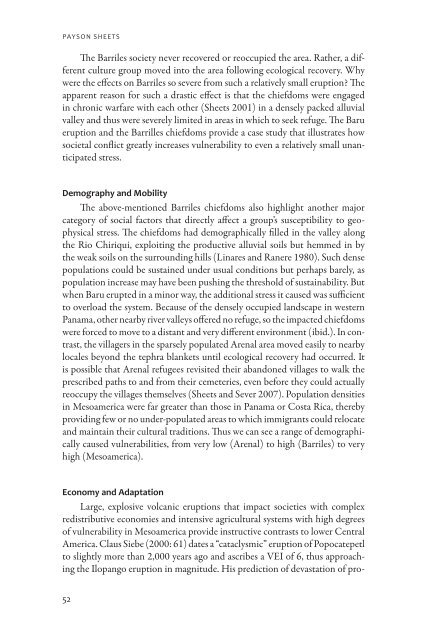free download - University Press of Colorado
free download - University Press of Colorado
free download - University Press of Colorado
Create successful ePaper yourself
Turn your PDF publications into a flip-book with our unique Google optimized e-Paper software.
Payson Sheets<br />
The Barriles society never recovered or reoccupied the area. Rather, a different<br />
culture group moved into the area following ecological recovery. Why<br />
were the effects on Barriles so severe from such a relatively small eruption The<br />
apparent reason for such a drastic effect is that the chiefdoms were engaged<br />
in chronic warfare with each other (Sheets 2001) in a densely packed alluvial<br />
valley and thus were severely limited in areas in which to seek refuge. The Baru<br />
eruption and the Barrilles chiefdoms provide a case study that illustrates how<br />
societal conflict greatly increases vulnerability to even a relatively small unanticipated<br />
stress.<br />
Demography and Mobility<br />
The above-mentioned Barriles chiefdoms also highlight another major<br />
category <strong>of</strong> social factors that directly affect a group’s susceptibility to geophysical<br />
stress. The chiefdoms had demographically filled in the valley along<br />
the Rio Chiriqui, exploiting the productive alluvial soils but hemmed in by<br />
the weak soils on the surrounding hills (Linares and Ranere 1980). Such dense<br />
populations could be sustained under usual conditions but perhaps barely, as<br />
population increase may have been pushing the threshold <strong>of</strong> sustainability. But<br />
when Baru erupted in a minor way, the additional stress it caused was sufficient<br />
to overload the system. Because <strong>of</strong> the densely occupied landscape in western<br />
Panama, other nearby river valleys <strong>of</strong>fered no refuge, so the impacted chiefdoms<br />
were forced to move to a distant and very different environment (ibid.). In contrast,<br />
the villagers in the sparsely populated Arenal area moved easily to nearby<br />
locales beyond the tephra blankets until ecological recovery had occurred. It<br />
is possible that Arenal refugees revisited their abandoned villages to walk the<br />
prescribed paths to and from their cemeteries, even before they could actually<br />
reoccupy the villages themselves (Sheets and Sever 2007). Population densities<br />
in Mesoamerica were far greater than those in Panama or Costa Rica, thereby<br />
providing few or no under-populated areas to which immigrants could relocate<br />
and maintain their cultural traditions. Thus we can see a range <strong>of</strong> demographically<br />
caused vulnerabilities, from very low (Arenal) to high (Barriles) to very<br />
high (Mesoamerica).<br />
Economy and Adaptation<br />
Large, explosive volcanic eruptions that impact societies with complex<br />
redistributive economies and intensive agricultural systems with high degrees<br />
<strong>of</strong> vulnerability in Mesoamerica provide instructive contrasts to lower Central<br />
America. Claus Siebe (2000: 61) dates a “cataclysmic” eruption <strong>of</strong> Popocatepetl<br />
to slightly more than 2,000 years ago and ascribes a VEI <strong>of</strong> 6, thus approaching<br />
the Ilopango eruption in magnitude. His prediction <strong>of</strong> devastation <strong>of</strong> pro-<br />
52





